The UN High Commission on Human Rights declared play a fundamental right of all children. And indeed, while the adults can cite numerous studies that tout the importance of play to a child’s development, the kids just simply want to play. Of course, the need for play does not distinguish between children of varying abilities—everyone needs and deserves play. And as play space planners and product manufacturers have increasingly prioritized inclusive play, more communities in general are becoming aware that inclusive play needs to go above and beyond ADA accessibility standards.
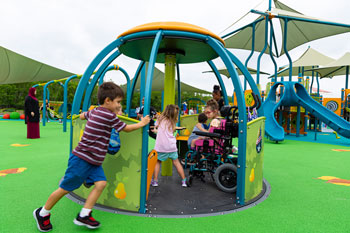
“Play is crucial for a child’s development, and that goes for any child, whatever unique abilities or needs they may have,” said Jill Moore, inclusive play specialist at a Delano, Minn.-based playground design firm and equipment manufacturer. “The play space supports emotional, social, cognitive and sensory development; it provides us with a safe place to explore challenge and risk, and an inclusive space is going to do all of that for every child, not just typically-developing.”
She explained that a child with a disability might need more practice in a certain area of development, be it social skills or motor coordination, etc., and to allow this to happen, the playground design needs to be made equitable so that the child can have the same access to these experiences as everyone else.
“It’s important for all people to feel like a space was designed for them—for their use, comfort and ability,” said Sarah Lisiecki, communication and education manager with a Fond du Lac, Wis.-based playground designer and equipment manufacturer. “Having room to maneuver a mobility device is important so everyone can be an equal part of the play experience. It’s also important that everyone has access to the most exciting play elements, and a ramp system can be part of this access. There are so many incredible developmental benefits that come from play, and we don’t want anyone to miss them!”
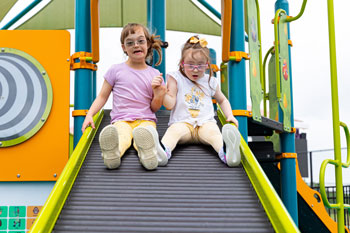
It’s also an important consideration to integrate all play features together, as opposed to having so-called inclusive amenities in separate areas. One survey conducted by Moore’s company found that three quarters of parents across the country believe it’s important that their kids have opportunities to play with a variety of children, including those with disabilities. “No one ever wants to be put on display for their needs,” said Moore. “If we’ve designed a space exclusively for kids with disabilities, then that space is automatically going to become very ‘other,’ and it’s not going to truly invite everyone to play. The goal of an inclusive space is that any kid of any ability can play equitably with their peers.”
Moore mentioned some examples of inclusive equipment, including a spinner that offers strategic seating and room for wheelchairs, and an accessible swing where there’s no need to transfer from a wheelchair, which can have one or two accessible bays. “A child who is using a mobility device can sit right next to or across from their peers. Everyone can participate in the spinning or the pushing, from the interior and exterior. No one is going to be on display for how they use the equipment or what their needs are.”
Moore pointed out that some kids with certain developmental disabilities might struggle with communication, and so activities that promote social play can be beneficial, like those already mentioned or a wheelchair-accessible glider or “even various multi-use spinners… any product that encourages face-to-face interaction.”
She said that when it comes to various developmental challenges, there is “such a wide range of kids who need different degrees of support, but there are plenty of strategies utilized.”
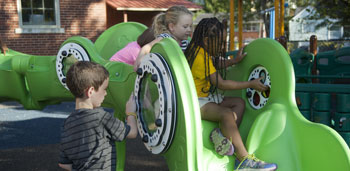
Designing for this demographic can also include developing motor planning skills, according to Moore, who explained that to accomplish a task, our brain has to go through steps to plan what we’re going to do and how we’re going to do it. “Children with ADHD or dyslexia may struggle with motor coordination and planning how they’re going to achieve this task. Obstacle courses require them to practice this motor planning skill, which connects to executive function—everything that comprises our ability to do day-to-day tasks, organize our thoughts and regulate our emotions. By formulating a plan of attack for getting through the course, it removes the pressure of completing the task and replaces it with play.”
Moore said it’s important to design with variety. “Children with autism or sensory processing disabilities, or other developmental disabilities, may get overwhelmed, and this causes their system to become dysregulated.” She explained that this can cause a fight-or-flight response, hence the concern for ‘runners.’ “When designing for inclusion, we want a variety of spinning, swinging and climbing, as these experiences are all necessary for sensory development, and also can act as an activity to calm or re-regulate these kids.”
Certain kids with developmental challenges may also get overwhelmed with certain aspects of the playground, according to Moore, and may gravitate toward “individual play opportunities that provide some retreat space.”
Lisiecki said it’s becoming more common to design places where children can step away from the action, which helps everyone to have an equitable opportunity for play. “Sometimes children will use these places to plan their play experience so they feel comfortable getting into the action and can have control over their play.”
“Children on the ASD spectrum or with other sensory processing differences can be especially overwhelmed by noise, movement or simply need a space to express themselves freely,” Lisiecki continued. She described a serenity play event they offer that benefits this demographic. “This fort-like environment offers special features like games, a spinning seat, a rubber kick pad, a mirror to help see and practice emotions and a variety of activities that can be calming and provide an outlet for stimming behaviors.”
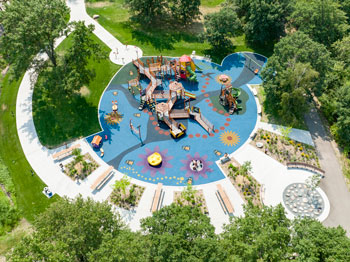
Moore added that these retreat spaces aren’t just for kids with autism or sensory disabilities, they also serve the needs of kids who are perhaps a bit anxious. “Every one of us needs an opportunity to retreat and collect our thoughts, so these spaces are a universal opportunity to provide that.”
When it comes to designs and products to address physical disabilities, Lisiecki mentioned their universal swing, a unique way for children to swing themselves, since research tells us that children like to have control over their play experience, and kids using mobility devices oftentimes don’t have this opportunity. The swing “provides the ability for a child to transfer independently and, unlike traditional swinging, kids can swing using their core, arms or legs.” She said it allows exploring new ways to swing, interact and play, and it incorporates rocking, the ability to sit or stand and offers engagement with peers.
“As an added benefit,” she continued, “kids on the ASD spectrum are able to demonstrate stimming behaviors in an environment where all children will be playing in a similar way. Leg movement and rocking are inherent in play on the (swing), and when kids sit in the seats, they’ll be working on eye contact while they engage with each other.”
Moore agreed that play is about exploring independence, and a big part of that is being able to control your environment. She elaborated on their inclusive spinner and swing, as both pieces were designed so the user could make them move. “Otherwise, if I want to spin or swing but have to wait until a caretaker or peer joins me, that’s not allowing me to play on my terms, it’s dependent on someone else’s energy and willingness.”
She also discussed their inclusive net structure, a rubber belting material used to create more accessible pathways, with plates in the spiral belting to perch, sit or rest. “It’s wide enough to support a user who’s crawling, or scooting, or simply needs more support than something like a net material alone. This provides an equitable opportunity for kids to maneuver to the top of the structure and go down the big slide or experience the thrill of being on top of the world—things that kids with physical disabilities haven’t always been invited to.”
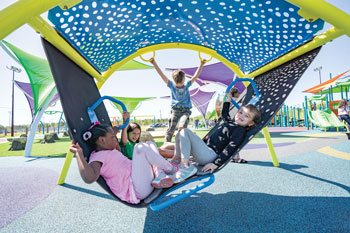
Moore—who uses a wheelchair herself—demonstrates the spiral belting system in a video online, climbing an impressive tower and accessing the big slide. She also points out that these products aren’t exclusive to kids with mobility devices. “It could be cerebral palsy or Down syndrome, motor coordination disabilities that may cause them to fatigue quicker and seek a respite space—such as the belting—or need additional support to help the child stay balanced and oriented.”
Signs can convey rules, equipment use and more, using words, symbols and multiple languages, and Lisiecki said communicating important information is critical to the safety and comfort of users. “If someone can’t understand what’s being conveyed, they may not feel the space was designed for them.” She described using communication panels, with “pictures and words for children to communicate how they’re feeling, what they want to play on, what hobbies they have and more. It’s an incredible way for kids of all abilities to be able to communicate regardless of how they choose to share about themselves.”
For those with visual differences, she said yellow boundaries are one way to communicate information, as it’s a color that’s easier to see, especially against a darker background. “It provides perceptible information for a safer experience and also creates an environment that’s designed for all people.”
Moore agreed and said there’s more conversation lately about meaningful design for users who are blind or have low vision and those who are deaf or hard of hearing. She pointed out that only around 8% of blind users can read braille, so more options need to exist. “Designing with bright color contrast, textures, even sound play—that helps this group with orientation and wayfinding at play.” For those who are deaf or hard of hearing, it’s about opening up the visual field, creating textured and visual cues, considering the space needed for two people to sign each other. “Things that really speak to the sensory usability of a space.”
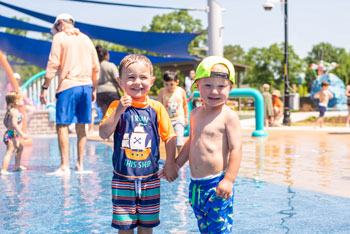
Central Creek Park opened in Goose Creek, S.C., in December 2022. The 13-acre site aimed to ensure that residents of all ages and abilities have access to high-quality experiences, providing the chance to “develop a fit, healthy lifestyle and inclusive frame of mind.” There’s a pavilion, walking trail, sport courts, splash pad, food truck court and a field and stage for community events.
“The goal during the planning stages was to make accessibility and inclusion a priority and beyond basic ADA guidelines,” said Parks and Recreation Director Crystal Reed. “Modifications exist all around the park, from wider sidewalks, extra handicap parking and adjustable basketball goals, to adult changing tables in the restrooms. We tried to reduce as many barriers around the park as possible.”
Moore’s company provided design input and products for the playground, which Reed described as the park’s highlight, with “many features that allow for easier access for those with disabilities, and with all of the equipment in the same space, it allows for children of all abilities to play together.”
She described 21 accessible ground-level components and nine transfers in the 2- to 5-year-old playground, and 37 accessible ground-level components and 12 transfers in the 5- to 12-year-old playground. “We wanted to make sure a majority of the equipment could be used by everyone!”
In the design phase, they made sure that equipment designed with adaptations wasn’t off to the side or all together but integrated throughout the playground. “Cozy domes” are scattered throughout the playground, and a center art piece of underwater caves and a submarine offer quiet places. “We have a variety of textures and colors throughout the playground, including sensory panels and a musical play area as well as music on a variety of features in the splash pad area,” said Reed.
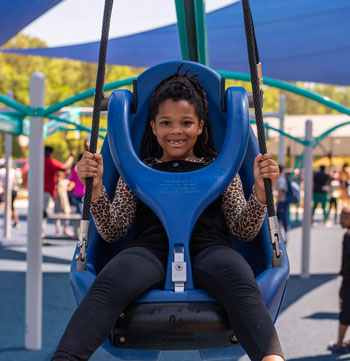
Pour-in-place rubberized surfacing—level with the sidewalks—was used throughout the play area to reduce barriers for wheelchairs and walkers, according to Reed. “Our park offers the most shade structures in the area because we were informed that temperature regulation for some of our special needs community members and those on medication would need this feature,” she added. “Feedback has been extremely positive, and residents are grateful for the planning and effort made to create a park for all.”
Looking at surfacing, Moore pointed out that while engineered wood fiber (EWF) is approved as accessible, it can cause difficulty for users with low balance or mobility devices. She said that if budgets dictate the use of EWF along with rubber, it’s important to be intentional about placement. For instance, if there’s a ramped structure with a slide, rubber surfacing should be used at the bottom, allowing a caretaker to bring a wheelchair, allowing for a steadier transfer. Also, “Turf can generate a fair bit of static if not treated properly,” said Moore. “Many manufacturers offer anti-static turf, which is ideal for children with medical implants such as Cochlear implants, Baclofen pumps, insulin pumps, etc.”
And she stressed that the environment and support features are crucial considerations. “A trip to the playground is all about can I get there, can I play there and can I stay there.”
She said things like shade and adult changing facilities are integral. “If someone with dwarfism goes to the park, they’ll need different seating than someone typically developing, thus it makes sense to design a variety of seating options into the space.”
With better inclusive practices taking root, many communities are interested in not only creating new spaces but revamping what they have, according to Moore. She described an elementary school in Hopkins, Minn.—Glen Lake—that has a few kids in their population with disabilities. A fifth and sixth grade class wondered why they couldn’t all play together, so they raised $530,000 to update their playground. Phase one involves getting some universally accessible pieces installed. “Communities need to approach inclusion for whatever speed is best for them to create an intentionally designed space that meets the needs of their individual community.”
“Sometimes communities have spaces that are great but feel like they need a few new play events to increase inclusivity and make the space new again,” said Lisiecki. She suggested that one popular way to achieve this is with a large electronic game that has no batteries or wiring and is “people-powered and totally inclusive.” With numerous game options, the piece provides a variety of developmental and physical benefits for people of all ages and abilities. “This play event was designed with assistance from a child using a mobility device and he was instrumental in making certain it was done exactly right and it was comfortable, fun and engaging for him and all children.”
Another design consideration involves multigenerational use, which can also benefit parents, grandparents and other caregivers. One strategy is adding play elements that are a comfortable height for an adult to interact with, according to Moore, who mentioned their inclusive swing and glider. “Both of these are at a height that an adult can push the child without undue stress. Also, there are plenty of activities being integrated with adults in mind, such as ninja courses or fitness trails through a park. Even raised garden beds are considerations for more accessible use for all ages and abilities.”
Moore is excited that more communities are working to make their play spaces truly inclusive, even at the neighborhood level, as opposed to when those playgrounds were mostly destination spaces that families would drive across state lines to visit. “We tend to find that one inclusive play space begets the next, and communities are generally excited to make the effort to become a more inclusive place for everyone.”
She said that an inclusive park or playground speaks to a community’s commitment to be “thriving and livable for all,” and as people become educated on what creating inclusion looks like, they realize these spaces don’t need to be giant, multi-million-dollar projects. “It can still provide some very impactful play that’s much closer to the families who need it within a certain size and price point.”
Moore also presents educational courses on inclusive principles. “I work with many parks and rec professionals from various municipalities who want to know what inclusion can look like for their community. Along with that, we work closely with landscape architects, architects, educators and community groups that are pursuing inclusive spaces. I’ll talk to anyone who’s willing to listen about inclusive play!” RM



